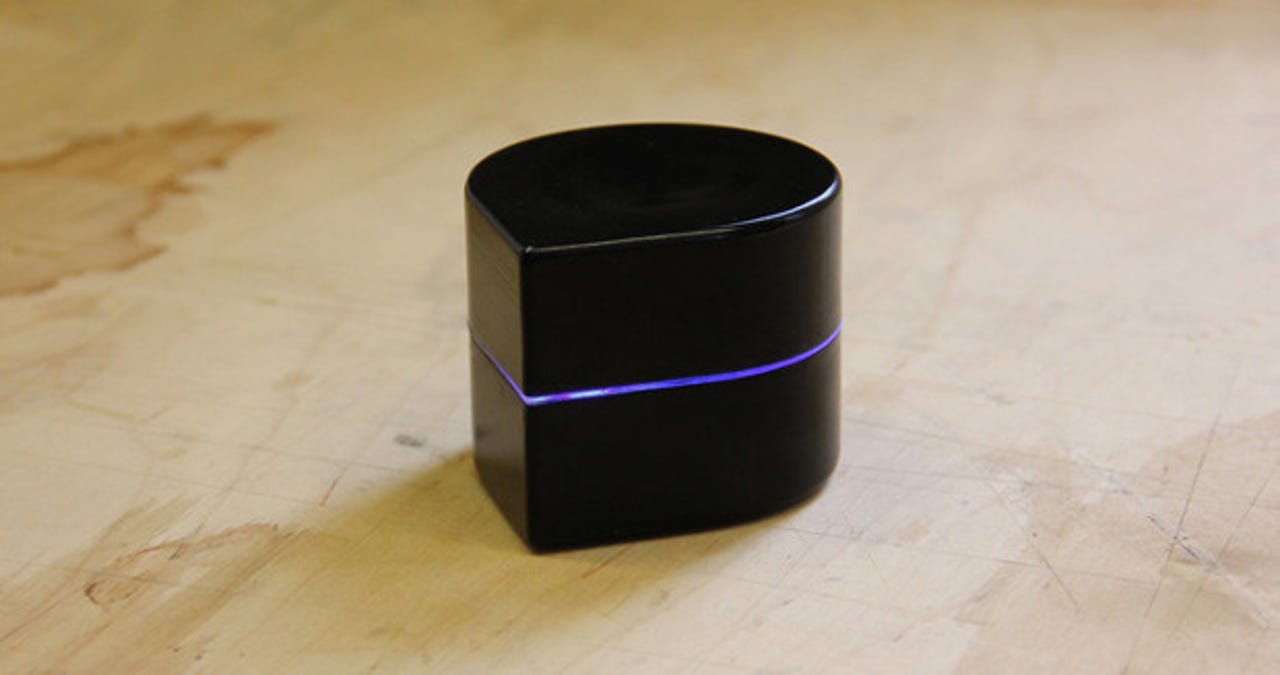Meet Zuta, the tiny printer that drives itself to make documents on the go


Printing as we know it hasn't changed in a long time — it's still all about moving a piece of paper under an ink-filled printing head, or using a laser to burn ink into paper. The same traditional thinking used for stationary printers got applied to devices designed for printing on the road — mobile printers are mostly bulky, expensive creatures, and the ones used for printing text and photos still cost a few hundreds of bucks.
More innovation stories
A few young students from Lev, the Jerusalem College of Technology (aka Lev Institute) decided to turn these conventions upside down. In a mobile-centric era where smartphones and tablets are ubiquitous, why have a piece of paper moving around when you can have the print head itself run on the paper?
The idea is the basis for Zuta (meaning 'a small thing' in Aramaic), a small robotic printer aimed at road warriors. Instead of carrying a big mobile printer, all you need is Zuta, and a flat surface to put the paper on. Zuta, the company behind the eponymous printer, hopes the device will appeal to architects, designers, engineers, and others, offering an affordable wide format alternative to the big and expansive wide format printers currently in use in those fields.
"Zuta is intended as a product for the mobile working environment. People are no longer working only in offices. They are working on the train, at coffee shops, so Zuta is for the mobile worker. A secondary market for us is architects and designers that need to print on larger sheets, and Zuta is a cheaper solution for them," Tuvia Elbaum, one of Zuta's co-founders, told ZDNet.
Elbaum and fellow co-founder Matan Caspi met through a program at Lev College's school of management that offered a bachelor's degree for working people with a strong interest in technology. Projects that are accepted onto the program can receive a small amount of initial funding to help get their business idea off the ground.
The idea for Zuta had been lingering in Elbaum's mind for a while, after having faced the need to print documents on the go, and not finding a product to meet that need.
"I had this idea in my head for some time," Elbaum said. "We presented it to some professors at our institute, and to the institute's management... We passed three committees, and got the initial funding. We used that money to hire an electrical engineer, one of the institute's top students, and started rolling out as a company."
Elbaum used his familiarity with the Jerusalem startup scene (he's one of the founders of Umoove, the face and eye tracking technology startup) to recruit a longstanding contact with knowledge in robotics, and a fifth staff member, a designer from Bezalel Academy of Design.
After making Zuta's public debut at Microsoft's ThinkNext event in Tel Aviv earlier this year, the company launched a crowdfunding campaign in April seeking $400,000 and reached its goal within a week.
A month later, when the campaign closed, it had raised $511,662 from more than 3,000 supporters of various types. According to Elbaum, the Kickstarter community has been more than just a source of financing, it also gave them feedback and ideas how to improve the product.
Around 1,600 people ordered different versions of Zuta. Along with a colour choice of black or white casing, the printer was offered at various price points, including $180 for the simple black version and going up to $300 for a special Kickstarter version with a green K logo embedded on top of the device. There was also a $10,000 version, engraved with the backer's name on the motherboard, although no one picked it up.
According to Leon Rosengarten, one of Zuta's robotic engineers, the aim of the printer was to make it as accurate as possible, yet as small as possible.
How does the device work? The edged end of Zuta's teardrop-shaped body, which holds an inkjet printing head and an Arduino board, aligns with the corner of the paper, giving Zuta its starting point. From there, Zuta begins to run on the paper, using a set of omni wheels and a high-resolution optical sensor to find its location and move around. The paper's width is preset in the settings dialogue.
In essence, it still prints like a regular printer, only it's the device that moves freely around the paper, while the page itself remains static — the opposite of how traditional printers work.
Zuta connects via Bluetooth to any device, be it smartphone, tablet, laptop, or desktop (Rosengarten says the company used a particular protocol removing the need for drivers) and is automatically recognised as a printer. It can also be connected to a Mac or PC as a regular printer, and the company is already working on iOS and Android apps too.
Zuta weighs in at 300g and will be made from polycarbonate. Its dimensions are far less than a traditional mobile printer, measuring only 10cm in height, and 11.5cm in diameter. "It's about the size of a softball," Elbaum said. The company had considered selling it with a plate to put the paper in, but the idea was scrapped.
The robotic printer will have a rechargeable lithium-ion battery onboard, which will be charged by micro-USB port at the bottom of the device (total runtime for one charge cycle will be about an hour). It will be activated by sliding a hatch on the bottom of the device that will reveal the printing head.
The ink-based head is designed to last 1,000 pages and the first version will print in grayscale. The good news is that Zuta will probably use some standard cartridge, the kind you can find in your neighbourhood store.
The company is working on improving the printer's resolution, and hopes to have the production machines printing 1.2 pages per minute. "It will depend on the final cartridge we will be using, but we hope to make it above 196 dots per inch," Elbaum said.
Current prototypes are still kind of slow, taking about 40 seconds to print an A4 sheet. Elbaum has said in the past that Zuta is designed for casual use, say two to four pages printed on the go — he wouldn't recommend it to print your Master's degree thesis, for example.
The company has big future plans for its little robotic prodigy. Zuta hopes to put wi-fi capabilities on future models, as well as the ability to print on other materials — such as cloth or wood — and, of course, to print in colour.
The product was initially scheduled to ship to the public in January next year with a $240 price tag. However, it is now planned for the Zuta to be on shelves at some point in the first quarter of 2015. Any delay could be down to the company's choice of hardware partner, which is yet to be set in stone.
"Each manufacturer has its own schedule and capabilities," said the Zuta co-founder.